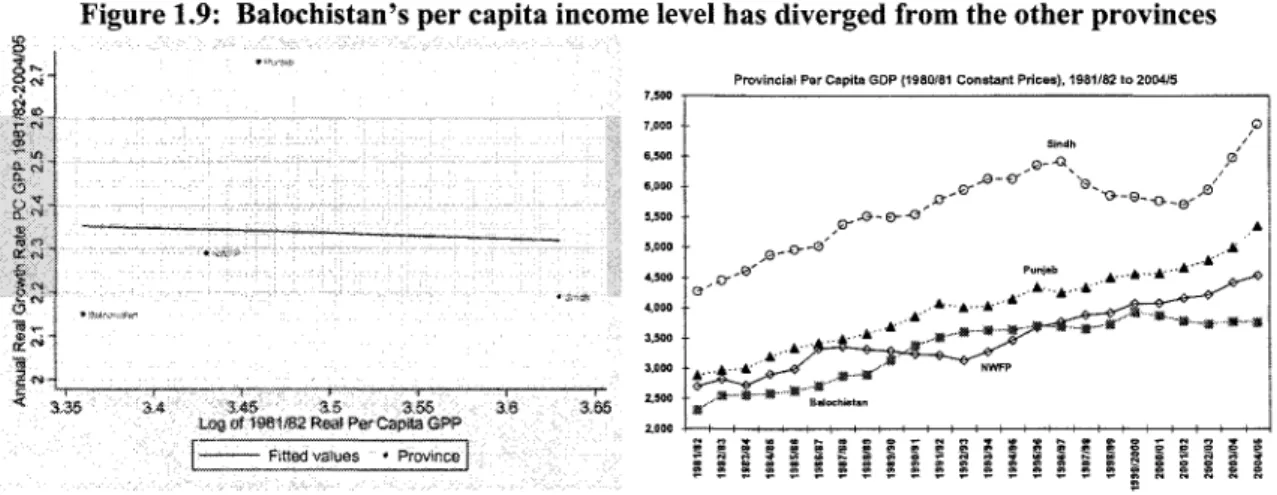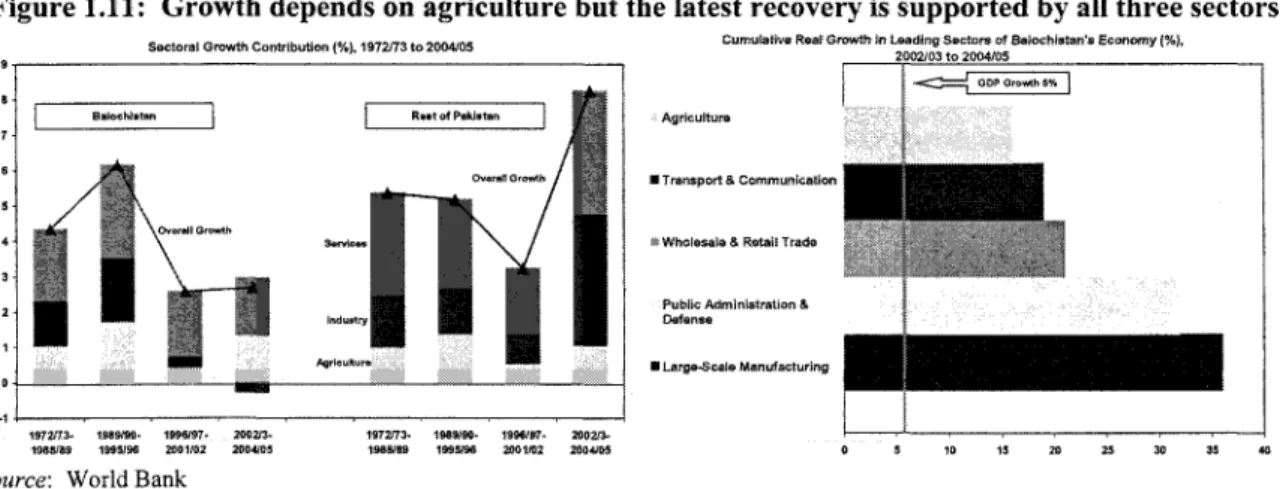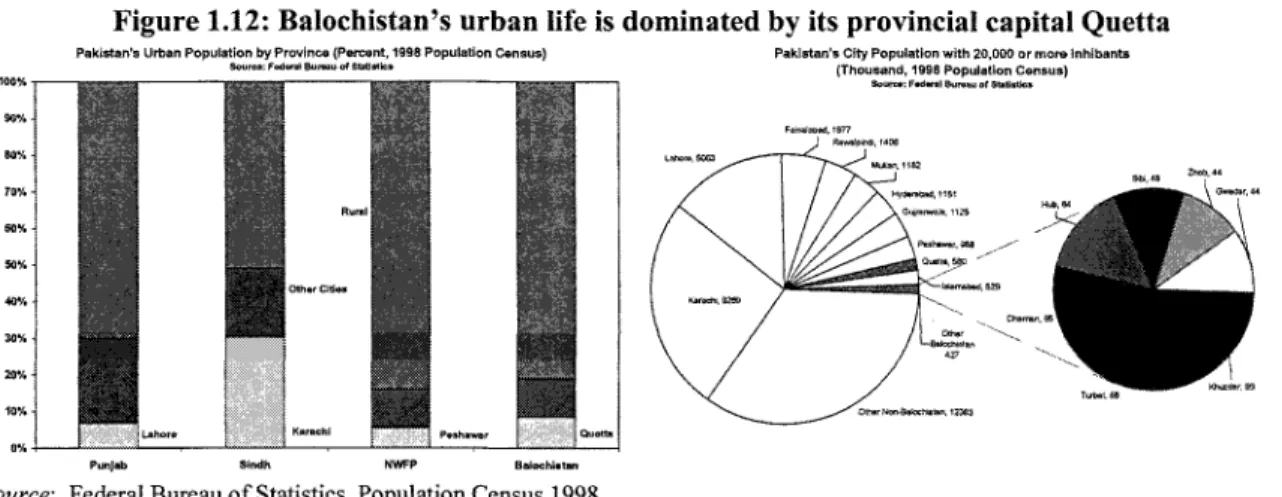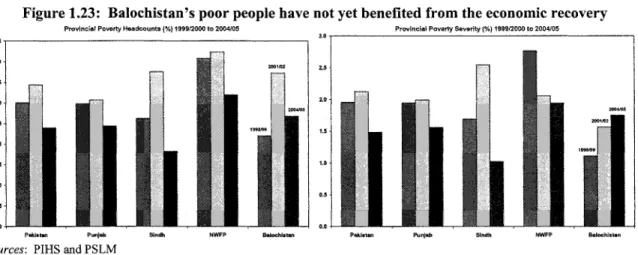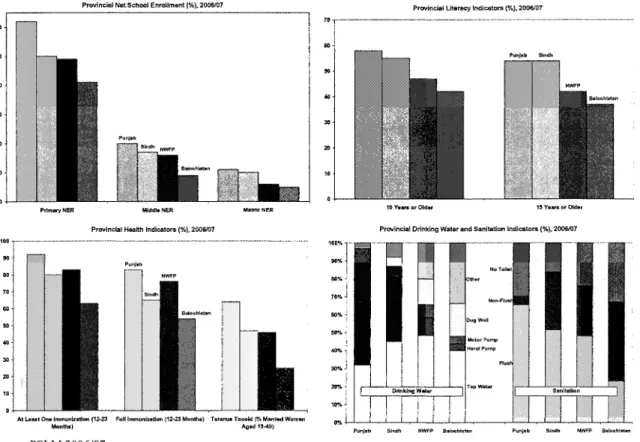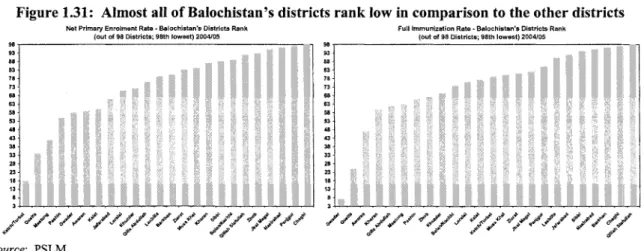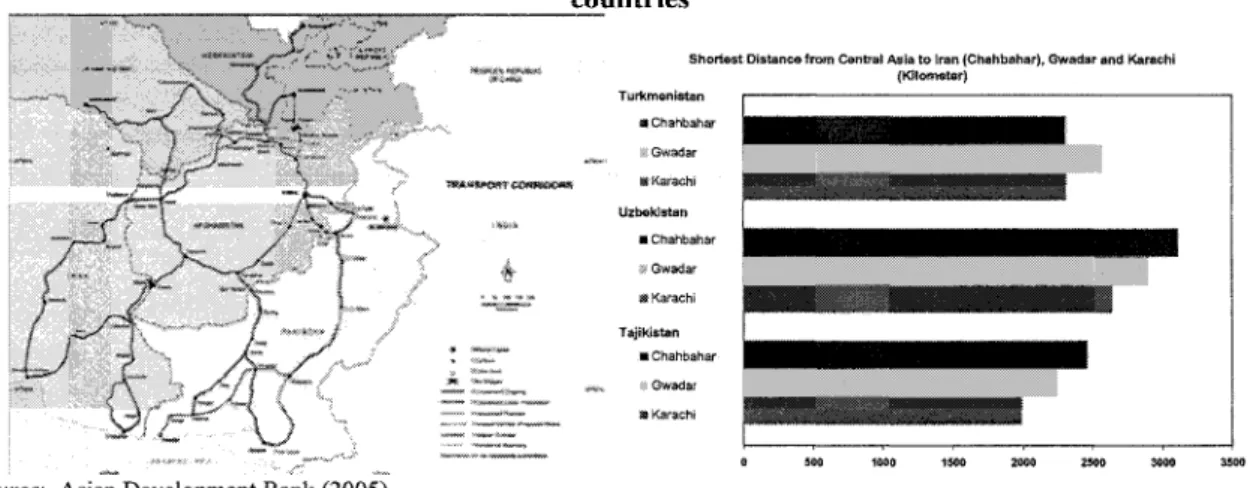May 2008
Document of the World Bank Report No. 40345-PK
Pakistan
Balochistan Economic Report
From Periphery to Core
(In Two Volumes) Volume II: Full Report
The World Bank The Asian Development Bank The Government of Balochistan
Report No. 40345-PK Pakistan Balochistan Economic Report Vol. II Public Disclosure AuthorizedPublic Disclosure AuthorizedPublic Disclosure AuthorizedPublic Disclosure Authorized
TABLE OF CONTENTS
PART 1: FROM PERIPHERY TO CORE ... 1
1.1 SETTING THE STAGE ... 1
1.2 ROADMAP ... 4
1.3 TAKING STOCK ... 8
Growth ... 11
Employment ... 16
Poverty Reduction ... 24
Social Development ... 29
PART 2: GENERATING GROWTH ... 33
2.1 2.2 2.3 2.4 2.5 2.6 2.7 2.8 OVERVIEW ... 33
TAPPING MINERALS DEPOSITS ... 40
Mineral Investment and Revenues ... 43
Thriving Mines in Thriving Communities ... 47
Improving Economic Linkages ... 48
Small Production, Large Potential ... 40
Way Fonuard ... 50
REVITALIZING PETROLEUM ... 52
Little Exploration, Declining Production ... 52
Fiscal Repercussion ... 55
Security Failure ... 53
Way Fonuard ... 57
GWADAR’S POTEN~AL ... 58
Long Standing Ambition ... 58
Transit Trade ... 59
Transshipment ... 62
National Export and Import ... 64
Industrial Development ... 66
Way Fonuard ... 69
Deficient Value-Chain ... 76
Way Forward ... 78
LINKING ENTERPRISES ... 83
Business Environment ... 83
Roads to Prosperity ... 89
Way Fonuard ... 100
THE RURAL ECONOMY ... 102
Recovering from the Drought ... 102
Rural Pover ty ... 103
Way Fonuard ... 107
LIVESTOCK AND RANGELANDS ... 109
Recovering from the Drought ... 109
Migration and Common Property Grazing ... 1 1 1 Constraints to Marketing ... 115
Way Fonuard ... 116
BEYOND GWADAR: COASTAL DEVELOPMENT ... 73
Large Pool, Small Catch ... 73
Land Trade ... 94
2.9 CROPS AND FRUITS ... 1 19 Recovering from the Drought ...
Underutilized Floodwater, Overutilized Groundwater ... 126
Low Water Productivity ... 129
Way Forward ... 131
2.10 THE WATER SCSRII ... 126
Running D r y ... 126
PART 3: DELIVERING SERVICES ... 136
3.1 3.2 3.3 3.4 3.5 3.6 OVERVIEW ... 136
TOWARDS AN EFFECTIVE AND ACCOUNTABLE STATE ... 139
The Challenge of Service Delivery ... 139
Large Bureaucracy ... 139
Incomplete Administrative Devolution ... 141
Tribe, Ethnicity, and Political Fragmentation ... 142
Social Mobilization ... 146
Way Forward ... 147
GAINING AN EDUCATIONAL FUTURE ... 150
The Testscore Puzzle ... 150
Public-Only, Inequitable Access ... 150
A Second Look ... 154
Educating Girls ... 158
Going Beyond Primary ... 160
Way Fonuard ... 161
MAKING HEALTH SERVICES REACH POOR PEOPLE ... 166
Health Outcomes -the Cheque is in the Mail? ... 166
Weak Expenditure Management ... 171
Failing Frontline Services ... 173
Accounting for Low Utilization ... ... 174
Way Fonuard ... 177
SECURING HEALTH THROUGH IMPROVED WATER SOURCES ... 180
Uneven Access, Uneven Quality ... 180
Multiple Players, Little Empowerment ... 182
Way Fonuard ... 184
ASSISTING POOR PEOPLE THROUGH CASH TRANSFERS ... 186
A Shallow Effort ... 186
Way Fonuard ... 187
PART 4: FINANCING DEVELOPMENT ... 189
4.1 OVERVIEW ... 189
4.2 FISCAL RECOVERY ... 191
Spending Spree ... 191
Debt Hangover ... 194
From Spending to Outcomes ... 195
Way Forward ... 200
Incomplete Fiscal Devolution ... 197
TABLES
Table 1.1: Balochistan’s stock taking o f challenges and opportunities across four dimensions ... 11
Table 2.1 : Balochistan’s growth pillars. sectors and areas ... 34
Table 2.2: Instruments for Generating Growth ... 39
Table 2.3: Balochistan’s tax regime i s in line with other countries ... 47
Table 2.4: Opportunities. Challenges o f Sustainable Mining and Strategic Responses ... 51
Table 2.5: Most countries in the regions are expanding their port capacity ... 64
Table 2.6: Gwadar’s Competitive Advantage and Industrial Development Potential ... 69
Table 2.7: Pakistan’s Potential Fish Catch ... 76
Table 2.8: The lost rangeland could have provided fodder for 0.5 million sheep or 2.9m goats ... 114
Table 2.9: Proposed Substitution o f Water-Intensive with Water-Efficient Crops in Irrigated Agriculture 133 Table 3.1 : Instruments for Delivering Services ... 138
Table 4.1 : Instruments for Financing Development ... 190
Table 4.2: Eligibility Criteria for Balochistan’s Local Government Performance Grants ... 199
Table 3.2: District Appointing Authorities ... 142
FIGURES Figure 1.1 : Pakistan’s Province o f Balochistan ... 1
Figure 1.2: Balochistan as share o f Pakistan along three dimensions ... 1
Figure 1.3: Framework ofthe Balochistan Economic Report ... 4
Figure 1.4: Balochistan has the weakest long-term growth record. but the ongoing recovery i s broad-based ... 8
Figure 1.5: Balochistan’s workers are less productive than workers o f the other provinces, but job creation increased noticeably in this decade ... 9
Figure 1.6: Balochistan’s poor people in rural areas have not yet benefited from the economic recovery .. 9
Figure 1.7: Balochistan’s social and gender indicators are low but improving ... 10
Figure 1.9: Balochistan’s per capita income level has diverged from the other provinces ... 13
Figure 1 . 10. Balochistan’s economic growth fell behind Pakistan’s growth mainly in the second half of the 1 9 9 0 ~ ~ even though structural change was slower ... 13
Figure 1.12: Balochistan’s urban l i f e i s dominated by i t s provincial capital Quetta ... 15
Figure 1.13: Low urbanization i s associated with low household durables in Balochistan and the rest o f Pakistan ... 16
Figure 1.14: Balochistan’s workers are less productive than those of the other provinces, but labor force participation increased sharply over the last years ... 17
Figure 1.15: Balochistan’s jobs are o f low quality ... 18
Figure 1.17: While public sector jobs pay regular wages, most workers hold own-account jobs ... 19
Figure 1.18: Public sector jobs set the wages for regular jobs, as informality outside o f agriculture has increased ... 19
Figure 1.1 9: Wages have started to increase across for regular and irregular wage jobs ... 20
Figure 1.20: Workers in Balochistan migrate less to other provinces than those o f the other provinces ... 21
Figure 1.21: Balochistan has a youthfid population structure ... 23
Figure 1.22: A skilled labor force will be a powerful force o f economic convergence ... 24
Figure 1.23: Balochistan’s poor people have not yet benefited from the economic recovery ... 25
Figure 1.24: Balochistan’s poorest o f the poor far worse ... 25
Figure 1.25: Growth was more pro-rich in Balochistan than in the rest of Pakistan, and inequality increased sharply ... 26
Figure 1.8: Balochistan has the weakest long-term growth record in spite o f the recent growth spur ... 12
Figure 1 . 11: Growth depends on agriculture but the latest recovery i s supported by all three sectors ... 14
Figure 1.16: Jobs in skilled agriculture and skills o f workers have grown ... 18
Figure 1.26:
Figure 1.27:
Figure 1.28:
Figure 1.29:
Figure 1.30:
Figure 1.3 1 : Figure 1.32:
Figure 1.33:
Figure 1.34:
Figure 2.1:
Figure 2.2:
Figure 2.3:
Figure 2.4:
Figure 2.5:
Figure 2.6:
Figure 2.7:
Figure 2.8:
Figure 2.9:
Figure 2.10:
Figure 2.1 1 : Figure 2.12:
Figure 2.13:
Figure 2.14:
Figure 2.15:
Figure 2.16:
Figure 2.17:
Figure 2.18:
Figure 2.19:
Figure 2.20:
Figure 2.2 1 : Figure 2.22:
Figure 2.23:
Figure 2.24:
Figure 2.25:
Figure 2.26:
Figure 2.27:
Balochistan’s urban poverty has already declined. and rural poverty could come down due to Balochistan’s poor people have weaker endowments compared to Balochistan’s non-poor
people, as well as the poor people in other provinces ... 27
Education has the largest impact on poverty reduction, but policies should take into account other factors as well ... 29
Balochistan’s provision o f education, health, water and sanitation compares poorly to other provinces ... 30
Almost all o f Balochistan’s districts rank low in comparison to the other districts ... 31
In education and immunization, girls and women lag more behind boys and men in Balochistan than in other provinces ... 32
The gender gap has begun to narrow in social and labor market indicators ... 32
Balochistan’s 29 districts ... 35
Even though global metal and mineral prices have risen sharply, Balochistan’s mining sector contribution to provincial GDP has stagnated and to national mining GDP has fallen ... 40
Balochistan’s mining sector ... 41
Balochistan’s good governance regime can be improved ... 45
Balochistan’s mining sector has a long way to go ... 46
Balochistan gas wells are depleting within the 15 years ... 52
As Balochistan’s gas fields are becoming less plentiful, their contribution to value added has declined ... 53
Balochistan accounted for three-fifth o f all terrorist attacks in Pakistan during 2006, and most ofthem took place in and around Dera Bugti ... 54
Gas-related straight transfers to Balochistan are on the decline, while gas sales in Balochistan are on the rise ... 56
While trade with Afghanistan and Iran has taken off, trade with Central Asia has declined ... 59
Pakistan’s trade with Central Asia i s insignificant ... 60
The shortest route to the sea does not end in Gwadar for the three Central Asian countries ... 61
Pakistan i s connected through feeder services to the East-West main line routing from northern Europe to Singapore, Hong Kong or Taiwan ... 62
Karachi and Qasim fair poorly in terminal performance indicators relative to Khor Fakkam and Salalah, the main regional transshipment hubs . In future, the number o f container ports could increase from 27 to 39 ... 63
The projected port traffic i s likely to exceed the available capacity at Karachi and Qasim within the next decade ... 66
Large Phase I1 investments are needed for port and road infrastructure ... 70
With more than two-third o f Pakistan’s coastline, Balochistan contributes only one-sixth o f Pakistan’s fisheries GDP ... 73
Production and exports o f fishery products has stagnated ... 74
Pakistan’s fish exports have lost in value due to declining shrimp production ... 75
Fisheries could become a vital income source from Gadani to Jiwani ... 78
Gwadar and Pasni lead in production value and productivity indicators ... 78
Balochistan’s enterprises are hard to find and generate little sales and jobs ... 83
Wholesale and retail trade dominates i s Balochistan’s primary business ... 84
Corruption, political uncertainty, irregular electricity and crime and theft are the major concerns o f Balochistan’s enterprises ... 85
Quetta ranks 114* among 194 cites overall, much worse than other cities in Pakistan ... 86
Balochistan’s population i s scattered across a vast land area ... 90
I s the glass half empty or half full? ... 91
higher pro-poor public spending ... 27
Poverty relates systematically to household characteristics ... 28
The social gap has begun to narrow ... 31
Figure 2.28:
Figure 2.29:
Figure 2.30:
Figure 2.3 1 : Figure 2.32:
Figure 2.33:
Figure 2.34:
Figure 2.35:
Figure 2.36:
Figure 2.37:
Figure 2.38:
Figure 2.39:
Figure 2.40:
Figure 2.41 : Figure 2.42:
Figure 2.43:
Figure 2.44:
Figure 2.45:
Pakistan has an extensive national highway network ... 92
The province allocates too much for new projects and too little for maintenance ... 93
Weak transport infrastructure restricts rural mobility ... 93
Some Central Asian countries have better energy endowments than others ... 96
Official traders don’t reside in Balochistan ... 98
Balochistan i s only now emerging from an eight-year drought ... 102
Agricultural output and labor productivity are s t i l l recovering from the drought ... 103
The contribution o f crops to agricultural GDP increased over the last six years ... 103
Rural consumption in 2004/05 was still far below the 1998/99 levels ... 104
Crop farming i s the most important source o f income and occupation. followed closely by non-farm work ... 104
A large part o f Balochistan’s rural population has no agricultural income ... 105
Poverty declines only at relatively high levels o f agricultural assets and production ... 105
Rural poverty varies more across agro-ecological zones than across income sources ... 106
Poverty varies widely across agro-ecological zone ... 106
Poverty among rural households without crop or livestock incomes differs widely ... 107
Balochistan’s livestock sector could expand to meet rising domestic demand ... 110
Balochistan’s livestock population has already recovered from the drought ... 110
The value o f Balochistan’s livestock increased in line with the rest o f Pakistan over the last decade ... 111
Figure 2.46: Balochistan’s drought in the early 2000s reduced fodder and livestock. inducing migration in search o f greener pastures ... 112
Figure 2.47: Overgrazing and drought lead to a degradation o f rangeland ... 113
Figure 2.48: The value and the composition o f crop production changed since the early 1990s ... 119
Figure 2.49: Some crops have done better than others over the last decade. partly due to differential changes in crop areas ... 120
Figure 2.50: The rise in irrigated areas has supported wheat production in the second half o f the 1990s’ and the production o f other crops in the early 2000s ... 120
Figure 2.5 1 : Balochistan’s crop yields are low compared to other provinces and countries ... 121
Figure 2.52: Farm incomes and irrigation systems vary widely across agro-ecological zones ... 121
Figure 2.53: Crop land per farm in canal commanded areas i s larger than elsewhere. even though geographic land per farm i s smaller ... 122
Figure 2.54: Balochistan’s farms rely overwhelmingly on family members and traditional seeds ... 122
Figure 2.55: Balochistan utilizes only two-fifth o f i t s water resources ... 127
Figure 2.56: Balochistan’s government spends too much on the electric tubewell subsidy and the Indus basin irrigation system. at the expense o f the bulk o f the farmers and geographic area ... 128
Figure 2.57: Power supply management could reduce the cost o f the electricity subsidy without ... 129
Figure 2.58: N o more than one sixth to one third o f abiana i s collected. and the rates do not reflect water usage ... 130
Figure 2.59: Balochistan’s water strategy requires substantial funding ... 135
Figure 3.1 : Balochistan scores lowest on satisfaction with public services. but the indicators improved from 2002 to 2004 ... 139
Figure 3.2: Balochistan’s bureaucracy i s biased towards low grades. and secretaries transfer frequently 140 Figure 3.3: Balochistan’s ethnic groups are regionally segregated and demand political representation 144 Figure 3.4: The degree o f competition in provincial and local elections has increased from low levels . 146 Figure 3.5: The testscore performance o f Balochistan’s public schools puts the other provinces to shame ... 150
Figure 3.6: Primary public schools in Balochistan enroll a similar share o f children as in the other provinces. but enroll a higher share o f non-poor. urban children ... 151
Figure 3.7: The growth in public schools in Balochistan has kept up with population growth ... 151
Figure 3.8: Balochistan’s private primary schools are hard to find ... 152
Figure 3.9:
Figure 3.10:
Figure 3.1 1 : Figure 3.12:
Figure 3.13:
Figure 3.14:
Figure 3.15:
Figure 3.16:
Figure 3.17:
Figure 3.18:
Figure 3.19:
Figure 3.20:
Figure 3.21:
Figure 3.22:
Figure 3.23:
Figure 3.24:
Figure 3.25:
Figure 3.26:
Figure 3.27:
Figure 3.28:
Figure 3.29:
Figure 3.30:
Figure 3.3 1 : Figure 3.32:
Figure 3.33:
Figure 3.34:
Figure 3.35:
Figure 3.36:
Figure 3.37:
Figure 3.38:
Figure 3.39:
Figure 3.40:
Figure 3.4 1 : Figure 3.42:
Figure 3.43:
Figure 4.1 : Figure 4.2:
Figure 4.3:
Rural Balochistan has worse school access than areas elsewhere ... 153
Some 700. 000 out o f Balochistan’s 1.100. 000 children aged 5 to 9 were not attending school in 2004105 ... 154
Children attending private schools outperform children from public schools in terms o f testscores ... 155
Some districts provide virtually no primary education. and those that do often have poor facilities ... 155
Since the early 2000s’ Balochistan has become a laggard on primary education spending ... 156
Textbook sometimes arrive late during the school year. partly due to a lack o f public funds 156 School enrolment i s high when households are satisfied with school services and facilities 158 Balochistan has a large gender gap in education. especially for children from poor families and with uneducated parents ... 159
The gender gap i s larger in rural than urban areas ... 159
Girls have fewer within-village schools to go to, and are more restricted in reaching outside- village schools, than boys ... 160
Children start primary school late, and only rarely go on to middle and high school ... 160
Middle and high schools are far in between in Balochistan, contributing to lack o f female teachers ... 161
Balochistan’s mortality rates are higher than in the early 1990s ... 167
Disparities in mortality rates are large ... 168
Balochistan’s child and mother service indicators have improved since the late 1990s ... 169
Public health spending increased in the first half o f this decade ... 170
Balochistan has narrowed the service delivery gap to other provinces, but i s s t i l l lagging behind ... 171
Balochistan’s public health facilities serve only few patients ... 173
Households in Balochistan are more dissatisfied with public health facilities than in other provinces, and use them less as a result ... 174
Distance, costs and quality are the main reasons for staying away from health facilities when sick ... 175
Household in Balochistan spend less on health than elsewhere, and most o f it on drugs ... 175
Private health consultations are expensive in Balochistan ... 176
Balochistan’s health centers have poor facilities but adequate stock o f medication ... 176
Balochistan has hired more health specialists than nurses, while vacancies and absenteeism remains a grave concern in rural areas ... 177
Parents choose private school for quality. and public schools for access and low fees ... 153
Teacher placement i s uneven. and teacher monitoring i s irregular ... 157
There i s some improvement in the nutritional status o f Balochistan’s children ... 167
Balochistan’s public health spending i s low by international comparison ... 172
Access to improved sources o f drinking water and sanitation increased in Balochistan ... 180
Balochistan is spending heavily on water supply and sanitation ... 181
Improved drinking water and sanitation i s associated with improved child health ... 182
The TMAs receive only 9 percent o f the budget o f the provincial consolidated fund ... 183
Balochistan’s children were poorer in the mid-2000s than in the late 1990s ... 186
Pakistan’s social assistance i s modest in amounts and small in reach ... 187
Balochistan’s public expenditures have increased in the last few years ... 191
Balochistan’s public spending has become more pro-poor, although some sectors have benefited more than others ... 192
Real per capita development spending increased especially for transport, irrigation, and law and order ... 192
Balochistan’s improved water access lags far behind the other provinces, and i s very low in rural areas and for poor households ... 181
Figure 4.4: Balochistan’s has a higher share in single-province projects o f the federal public sector
development program than NWFP and Sindh ... 193
Figure 4.5: The per capita development spending premium o f Balochistan increased once federal development spending i s taken into account ... 194
Figure 4.6: Balochistan’s revenues increased at a slower pace than i t s spending ... 194
Figure 4.7: Balochistan’s public debt increased in the last two years. as did the throwforward o f i t s Figure 4.8: The structure o f fiscal inter-governmental relations in Balochistan ... 198
Figure 4.9: W h i l e transfers to local government have increased. the bulk o f the resources remains at the province level ... 200
Figure 4.10: Balochistan’s tax collection effort looks fable. but more resources are forthcoming through the NFC Award ... 204
development portfolio ... 195
BOXES Box 1.1: Box 1.2: Box2.1: Box 2.2: Box 2.3 Box 2.4: Box 2.5: Box 2.6: Box 2.7: Box 2.8: Box 2.9: Box 2.10: Box 2.1 1 : Box 2.12: Box 2.13: Box 2.14: Box2.15: Box 2.16: Box 2.17: Box 2.18: Box 2.19: Box 2.20: Box 2.21 : Box 2.22: Box 2.23: Box 2.24: Box 2.25: Box 2.26: Box 2.27: Box 2.28: Box 2.29: Box 2.30: Box 2.3 1 : Box 2.32: Box 2.33: Basic Services . a Public Responsibility ... 6
Afghan Refugees in Balochistan ... 22
Balochistan’s coal sector i s in need o f modernization and consolidation ... 42
Marble and Granite mining in Balochistan ... 43
The Geological Survey o f Pakistan ... 44
Marble City ... 50
Creating conditions o f accountability: the police ... 55
Central-South Asian road corridors ... 61
Gwadar as China’s energy hub? ... 62
Pakistan’s export-less economic recovery ... 65
Capacity Expansion Plans for the ports o f Karachi and Qasim ... 66
A port as catalyst for industry clustering: the case o f the port o f Sohar ... 67
Gwadar and Pakistan’s Vision 2030 ... 68
Thailand’s Eastern Seaboard Program ... 69
Pakistan’s National Trade Corridor Improvement Program (NTCIP) ... 72
Pakistan’s Fishing Zones ... 74
Foreign trawlers deplete local fish stocks ... 74
Balochistan’s Fish Harbors ... 77
The growth o f the Chilean salmon industry - an example o f effective public-private partnership ... 81
Insurance against natural calamities ... 82
The ups and downs o f Lasbela’s industrial estates ... 88
Pakistan’s energy strategy ... 95
Turkmenistan-Pakistan-India Gas Pipeline ... 97
Copper mining - on the road to success ... 42
Balochistan’s mining technical assistance project ... 51
Gwadar’s development spur ... 67
Thailand’s zoning policy ... 89
The Bus Service Koocha-Khuzdar as Lifeline for Employment ... 94
Illegal trade o f Pakistan with Afghanistan and Iran through Balochistan ... 99
Balochistan’s ago-ecological zones ... 106
White Revolution ... 109
Balochistan’s livestock breeds ... 111
Views on rangeland management - equilibrium versus disequilibrium approaches ... 115
The Loess Watershed Rehabilitation Project ... 118
The Changing Nature o f Transhumance in Koocha ... 113
B o x 2.34:
Box 3.1:
B o x 3.2:
B o x 3.3:
B o x 3.4:
B o x 3.5:
B o x 3.6:
B o x 3.7:
B o x 3.8:
B o x 3.9:
B o x 3.10:
B o x 3.1 1 : B o x 3.12:
B o x 3.13:
B o x 3.14:
Box 4.1 :
Selected government initiatives in agriculture ... 125
Social mobilization and drought mitigation ... 147
The challenge o f accountability ... 158
Tribal organization in Balochistan ... 143
The Balochistan Education Foundation - promoting private-public partnerships ... 163
Reducing teacher absenteeism - two success stories ... 164
Which trend, which survey? ... 166
HIV/AIDS in Balochistan ... 168
Why Poor People Have Poor Health ... 169
Foreign health projects in Balochistan ... 172
Balochistan’s unmet family planning needs ... 174
Balochistan’s 2006 draft health strategy ... 178
Selected government initiatives in health ... 179
The Lodhran Pilot Project ... 185
Piloting Conditional Cash Transfers in Pakistan ... 188
The Balochistan Resource Management Program ... 201
List of Background Notes Prepared F o r The Balochistan Economic Rep0 rt ... 205
References ... 206
MAP P A M 5 6 2 8
PREFACE AND ACKNOWLEDGEMENTS
This report i s a joint product o f a team from the Government o f Balochistan, the World Bank and the Asian Development Bank. In April 2006, the Balochistan Government constituted a counterpart team o f government officials, who were closely involved in the Report’s preparation. T h i s team was headed by Mr.
K. B. Rind, former Chief Secretary and Mr. Qayyum Nazar Changezi, former Additional Chief Secretary (Development), Government o f Balochistan, and included Mr. Ghulam Muhayuddin Marri, Chief Economist and Mr. Zulfiqar Durrani, Chief o f Section (Foreign Aid). The task team also benefited from the considerable support o f the Secretaries o f Planning and Development, Finance, Excise & Taxation, Local Government and Rural Development, Services and General Administration, Education, Health, Population Welfare, Livestock, Agriculture, Fisheries, Mines and Minerals, Irrigation and Power, Transport, Communication and Works, and Industries Departments and the Balochistan Public Service Commission, Provincial Public Accounts Committee, Accountant General, Bureau o f Statistics, Provincial Environment Protection Agency, Mining Association o f Pakistan, Small and Medium Enterprise Development Association, Balochistan Coastal Development Authority, Balochistan Development Authority, Gwadar Development Authority, Gwadar Port Authority, National Highway Authority, Geological Survey o f Pakistan, Arid Zone Research Centre, Water and Sanitation Agency, Water and Power Development Authority, Balochistan Resource Management Program, Quetta Chamber o f Commerce and Trade Association, Port Qasim Authority, Karachi Chamber o f Commerce and Industry and many other institutes.
The report was prepared by Kaspar Richter and Zahid Hasnain in the Poverty Reduction and Economic Management (PREM) unit o f the World Bank’s South Asia Region, under the guidance o f Satu Kahkonen, Lead Economist, Manuela Ferro, former Lead Economist, Ijaz Nabi, Sector Manager, Yusupha Crookes, Country Director, John Wall, former Country Director, Ernest0 May, Sector Director, and Sadiq Ahmad, former Sector Director. The World Bank peer reviewers were Farrukh Iqbal and Mark Thomas. The team from the Asian Development Bank comprised Safdar Parvez, Madiha Ahmed and Farzana Noshab. Khalid Ikram provided overall guidance for the report.
The report draws upon contributions from Anjum Ahmad and Madiha Ahmed (Private Sector Development), Shahid Ahmed (Water Resource Management), Shahid Amjad (Fisheries), Asif A l i (Procurement Systems Performance Assessment), Ismaila Ceesay (Public Financial Management and Accountability Assessment), Raja Rehan Arshad, Nadir Abbas, Kevin Crockford and Ambreen Malik (Water Supply and Sanitation), Agnes Couffinhal and Inaam Haq (Health), Mohammad Farooque Chaudhry (Development o f Gwadar Port and Coastline), Richard Damania (Livestock and Rangelands), Hark Gazdar (Social Structures and Migration), Zahid Hasnain (Governance and Decentralization), Roland White (Local Government System), Marc Heitner and Waqar Haidar (Oil and Gas), Rasmus Heltberg and N e i l s Lund (Social Protection), Sadaqat Hanjra (Livestock), Khalid Ikram (A Vision for Balochistan), C. Bert Kruk and Bradley Christopher Julian (Container Terminal Facilities in the Arabian Sea Region), Hanid Mukhtar (Fiscal Situation and Issues), Shaheen Malik (Gross Domestic Product), Eric Manes and Tilahun Temasgen (Business Constraints to Growth), Naveed Naqvi (Education), Zafar Iqbal Raja (Transport), Rashed-U1- Qayyum (Crops and Horticulture), Michael Stanley and Ekaterina Koryukin (Mineral Sector), and Syed Sayem Ali, Martin Cumpa and Nusrat Chaudhry (Data Analysis). Irum Touqeer and Arlene D. Reyes provided invaluable assistance in handling all logistical arrangements for the mission, and with processing the report.
The report team benefited greatly from collaborative work with the Government o f Balochistan counterpart team during three preparation missions (May and December 2006 and January 2007). The counterpart team coordinated all government inputs, and provided comments, feedback, and guidance to the study team at all stages o f the analysis and report preparation, and helped facilitate interaction with other line departments.
PART 1: FROM PERIPHERY TO CORE
A
1.1 SETTING THE STAGE
L
1.1 Balochistan offers some o f the best assets for development. Balochistan i s generously bestowed with natural and locational resources. It possesses the largest land area o f any province o f Pakistan, proving vast rangeland for goats, sheep, buffaloes, cattle, camels and other livestock. I t s southern border makes up about two thirds o f the national coastline, giving access to a large pool o f fishery resources. As a frontier province, it i s ideally situated for trade with Iran, Afghanistan, Central Asia and the Persian Gulf countries.
Over the last four decades, i t supplied cheap natural gas to Pakistan’s economic centers, supporting the country’s industrialization. The province also claims large deposits o f coal, copper, lead, gold and other minerals.
1.2 And yet, Balochistan’s economy has not done well (Figure 1.2). The province has Pakistan’s most anaemic growth record, worst infrastructure, worst water crisis, and weakest fiscal base. The poor economic performance leads to poor living standards. Balochistan has the highest poverty-along with NWFP, lowest social indicators, and, in parts o f the province, the weakest state institutions. Last but not least, newspapers carry almost daily headlines about internal conflicts in this frontier province. A l l this has earned Balochistan a reputation o f being a backward region, far distant from Pakistan’s economic hubs, with a l i f e burdened by the toils o f the field and rangeland and tribal disputes rather than a hub o f activity surrounding world-class mining explorations, modem trade links, sustainable agriculture and an empowered community.
Figure 1.2: Balochistan as share o f Pakistan along three dimensions
Source: Population Census 1998 and World Bank
1.3 Many developing countries have well-recognized areas where poverty has been persistently high and economic growth has not kept up with other regions. The western provinces o f China, the Northeast o f India, the Southern States o f Mexico, the West o f Argentina, the Northeast o f Thailand and the Northeast o f Brazil are just few examples o f such “lagging regions”. Similarly, developed nations, such as the Canada, Italy, or the USA also have regions with chronically low incomes compared to national averages. Economic geography, a branch in economics developed in the 1990s, i s all about where economic activity takes place.
It offers two concepts that are important in understanding lagging regions (Krugman 1998). First, differences in economic development across locations can emerge from underlying, inherent differences in those locations, such as climate, sea access and ge.ography. Second, such initial disadvantages embedded in geography, climate, policy biases or cumulative outcomes o f historic accidents, can lead to regions failing to develop a self-enforcing economic dynamism. Thin markets with l i t t l e backward and forward linkages, low purchasing power, weak skills o f the labor force and o f local administrations combine to make them unattractive for business. The challenge o f such regions i s to grow and converge with the other regions in the country.
1.4 Inherent
geographical weaknesses led over the centuries to low population density. The modernization process, which transformed the country from a poor rural nation into a semi-industrialized economy, has not benefited all provinces equally. Pakistan’s growth poles developed along the Indus river, leaving the other parts o f the country as agricultural hinterland. A diversified economy in Karachi and Punjab’s urban centers coexists with a less developed and more rural economy in the rest o f the country. Combined with political neglect, this destined Balochistan to the periphery o f economic and institutional development.
In many ways, Balochistan i s a prime example for the relevance o f these ideas.
1.5 As Balochistan was at the fringes o f the development process for far too long, knowledge about the province’s assets, challenges, and national contributions remains partial and cast in preconceptions. As a result, there i s l i t t l e appreciation about the other, equally important, Balochistan that in many ways i s at the core o f Pakistan’s growth strategy. The province i s embracing the window o f opportunity arising from national economic reforms and global integration to leverage i t s formidable resources and meet the challenge o f development. First, Balochistan has unleashed reform due to the strong leadership as well as the tough lessons learnt from an eight-year drought and two-year fiscal crisis. Second, the good performance o f the national economy has boosted public investments in the province to record levels. The provincial and federal governments have launched major uplift initiatives in economic and social sectors, invested in infrastructure to improve connectivity and initiated administrated change across all layers o f government (Table 1.1). Third, just as Balochistan’s Sui gas fuelled Pakistan’s industrialization in the second half o f the 20” century, i t s trade and energy ties with Iran, the Middle East and the rest o f the world are supporting Pakistan’s economic expansion today. In particular, boosting energy supply depends to a large degree on pipelines and transmission lines from Iran, Middle East, and Central Asia that pass through Balochistan; and scaling up national trade hinges largely on turning Gwadar into a viable, well connected port, as well as transforming Balochistan’s natural riches in mining, fisheries, and agro-products into profitable exports. Combined with the admirable resilience and resourcefulness o f Balochistan’s people, these programs and projects can overcome the impediments that have held back provincial prosperity for decades.
Seven Pillars of Pakistan's PRS Pillar I: Macroeconomic Stability and Sectoral Drivers of Economic Growth
I
Pillar 11: Crafting a Competitive Advantage for Domestic and
I Global Markets
Opportunity for Balochistan
Exploiting the diverse natural resource base and moving up value-chain
Developing the locational advantage
Pillar VII: Targeting the Poor and the Vulnerable
I
Improving skills in support of growth
I
IPillar 111: Harnessing the Potential of the People
Making economic development inclusive Pillar IV: Financial Sector Deepening and Economic
Development Expanding access to credit for enterpreneurs
Integration to overcome remoteness, increase market size and economies of scale
Reducing cost of doing business and providing basic services with participation of people
Pillar V: World Class Infrastructure
Pillar VI: Effective Governance and Management
1.2 ROADMAP
GOAL
1.6 This report offers an empirical analysis o f provincial economic development and the ways in which the provincial and federal governments, supported by donors, can help to foster it. It i s organized around three topics: the stock taking of economic outcomes over the last decades; the strategies for inclusive economic development of generating growth, delivering service, and financing development in the future;
and the instruments for today’s economic policies to bring about the required changes. Specifically, the report (Figure 1.3):
(a) takes stock of Balochistan’s outcomes on growth, employment, poverty and social development;
(b) conducts a thorough analysis of the three strategies o f generating growth, delivering services, and financing development; and
(c) provides the four instruments o f investment, innovation, integration, and institutions to bring about the required economic policy changes across the three strategies.
Balochistan Development - From Perlphery to Core i
Figure 1.3: Framework o f the Balochistan Economic Report
OUTCOMES Profitable Enterprises Productive Jobs Household Consumption Hum; Capital
STRATEGIES Generating Growth -
-\ Financing Development 2
2 \
INSTRUMENTS Investment Innovation Integration Institutions
1.7 The five main findings of the report are as follows. First, there are good reasons to be optimistic about Balochistan’s development. Provincial and federal reforms, the synergies between Balochistan’s and Pakistan’s development agenda in the areas of energy and trade, and the strong performance of the national economy present a unique opportunity to move Balochistan from the periphery to the core o f economic development to the benefit of i t s people. Second, in order to overcome the challenges that held back provincial development for many decades, Balochistan should pursue a development agenda around generating growth, delivering services, and financing development. This approach can make sure that Balochistan’s development path i s inclusive, where the gains are shared across regions and population groups. Third, generating growth requires leveraging Balochistan’s resource and locational advantages, deepening i t s capacity for value-addition, and strengthening the foundations for business activity. Fourth, delivering services depends on improving the public administration, making devolution more effective and scaling-up of basic services with innovative approaches involving the private sector and communities.
Finally, financing development relies on a prudent management of provincial expenditures, strengthening the capacity for revenue collection, and advancing fiscal devolution.
1.8 The three strategies reflect three broad lessons from the development experience around the world.
The first strategy LLGeneruting Growth” i s about fundamental change in economic structures, the movement of resources out o f agriculture to services and industry, and about transformations in trade and technology.
Since the most powerful and the central force for economic growth i s the private sector, the creation o f a good investment climate-one that encourages firms, both small and large, to invest, create jobs, and increase productivity-is at the center of this strategy. The strategy lays out a way for Balochistan to share Pakistan’s ambition o f sustaining growth around 7 percent per year. This requires developing the provincial
economy around four thematic thrusts: (i) exploiting the diverse natural resource base; (ii) developing the location advantage; (iii) upgrading the value chains associated with (i) and (ii); and (iv) strengthening the foundations o f business activity. The fourth pillar includes law and order. Security issues are a direct obstacle primarily for the exploration and exploitation activities in natural gas. But these problems in selected districts affect the perceptions o f potential investors for the entire province and thereby lower investments in other sectors as well. Skill development i s another dimension o f business activities, as Balochistan’s labor force requires human capital to embrace economic opportunities. Among the 2.3 million provincial workers, some 1.4 million have no schooling at all, and only 70,000 practice crafts and related trades.
1.9 The second strategy “Delivering Services” i s about changes to social l i f e - in health and l i f e expectancy, in education and literacy (to develops skills in support o f growth), in population size and structure, in gender relations, and in social relations. For example, improvements in the status o f women i s essential to progress in a number o f areas, including child well-being, family planning, labor force participation, and community empowerment. The challenge to policy i s to help release and guide these forces o f change. The strategy proposes measures to improve the effectiveness o f the public administration at the provincial and local levels, to scale up basic services in education, health, water supply and sanitation, and social assistance to people, and to foster mechanisms for accountability. Social development w i l l also require involving the private sector and communities in the delivery o f services. One crucial aspect i s social mobilization by creating agency and voice for poor people to become part o f the development process.
1.10 Generating growth and delivering services require resources. Yet, public spending absorbs scarce domestic resources and imposes an excess burden o f taxation that can get in the way o f economic growth.
While foreign aid flows are an essential cheap source o f finance for developing economies, they are often small and can delay much needed policy change. Since Balochistan’s development needs will always outstrip i t s revenues, the third strategy “Financing Development” emphasizes a careful prioritization and an effective management o f provincial public expenditures as well as providing the fiscal space for local governments. It also highlights the need for upgrading the system o f revenue collection as Balochistan’s tax base expands with economic growth. These efforts will help to ensure sustainable fiscal positions which in turn are crucial to give confidence to firms in making risky production decisions. They will also promote local accountability by raising the discretion o f local governments to respond to local needs.
1.11 The three strategies jointly help to make sure that Balochistan’s development path i s inclusive and the benefits o f growth are shared across regions and population groups. T h i s i s not an automatic process, nor i s it a process o f “trickle down”. It i s not enough simply to assume that everyone will eventually gain if the economy continues to grow. A farmer who lacks access to a navigable road w i l l go on struggling -
until decision-makers act to rehabilitate the feeder roads and provide access to market centers. A girl who spends her days working at home rather than learning to read will have l i t t l e to show for her country’s economic expansion - until a school i s setup in her village that gives children the opportunity to become literate. As the farmer and the girl gain the tools to participate in the economy, they can go on to contribute to and extend the country’s growth run.
1.12 The strategy o f generating growth contributes to inclusive development in two ways. It argues for the parallel development o f Balochistan’s diverse resource and locational assets for the benefit o f different regions and occupations. And it makes the case for lifting rural livelihoods in support o f the four-fifths o f the population residing in villages by highlighting the need for connectivity, infrastructure and services in support o f the rural economy. Similarly, the strategy o f delivering services makes two contributions to inclusive development. I t draws attention to the urgency o f building human capital, which i s linked to better family health and participation in society, higher productivity o f farmers, workers and small-business owners alike, and thus higher growth. Human capital also endows people with the ability to gain well- enumerated jobs elsewhere and support the economy at home through remittances. In addition, the strategy
